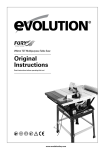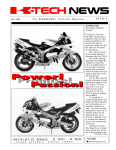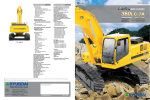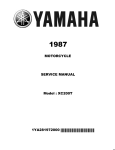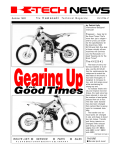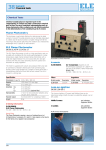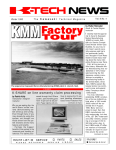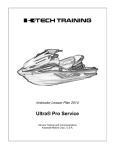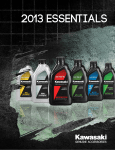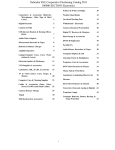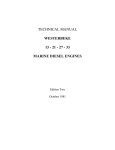Download K-Tech News Vol. 3 No. 2
Transcript
The Kawasaki Technical Magazine Summer 1990 The ZEPHYR W TM Vol. 3 No. 2 : High-tech details ith all the fanfare and hoopla surrounding the spectacular new ZX-6 and ZX-11, the ZR550-B1 may have rolled into your store almost unnoticed. The truth is that behind the ZEPHYR’s understated deep blue paint and clean, sweeping lines lies a bike armed to the sprockets with high-tech features. See Page 2 . . . ROUTE LIST: o P L E A S E SERVICE R E T U R NT O o PARTS S E R V I C E o SALES L I B R A R Y Inside! n Service tips galore. . . S H O P The ZEPHYR by Jerry Heil Training Development Coordinator A quick look over before taking the handsome new ZR550-B1 ZEPHYR out for a morning ride reveals a long list of high-tech details. Eccentric chain adjusters on the swingarm ensure optimal wheel alignment and save time on chain adjustment. The swingarm itself is aluminum, made of 75mm x 30mm boxsection extrusions, and it boasts a grease fitting installed just in front of the tire to speed maintenance. Rear wheel travel is a generous 4.5 in. Piggybackstyle reservoir shocks give the bike a traditional look and make it easy to adjust spring preload by turning the cam collars. The nitrogen gas-charged shock absorbers have fourway adjustable rebound and compression damping; the rider can select the damping that best suits the road and load conditions. The rear brake has a dual piston caliper and the 230mm disc has an effective diameter of 217mm. Front brakes are 300mm discs of the semi-floating type and have an effective diameter of 272mm. Front calipers are dual-piston type. Both front and rear calipers use sintered 2 l K-Tech News TM T A L K / T E C H N I C A L : High-tech details bronze-type rectangular brake pads though the parts are not interchangeable from front to rear. These brakes coupled to a 394 lb. dry weight give the ZEPHYR truly impressive stopping performance! Stout 39mm front fork tubes with 3mm wall thickness support the front justable and the clutch lever is five-way adjustable to fit any size hand. Push-to-cancel turn signals are a handy addition. Dual trip odometers can be used to keep track of the distance from the last fuel stop and total trip mileage. A quiet but healthy exhaust note comes from suspension. Rake is 27 degrees and trail is 4.1 inches. Front wheel travel is 5.5 inches. The frame is built from high tensile steel tubes with a 1.6mm wall thickness. The ZEPHYR is 40mm longer than the GPz models with a wheelbase of 1440mm. While throwing a leg over the ZEPHYR, you will notice many more details. The custom-looking textured seat is wide, comfortable and very low at just 30.3 inches off the ground. The “superbike”-style tubular handlebars provide a sporty but comfortable riding position. The brake lever is four-way ad- the four-into-one pipe. Dual overhead cams borrowed from the KZ550-H model open the single intake and exhaust valve in each cylinder. The reliable new ZEPHYR uses valves, tappets, and shims common to all the KZ550 engines. Air and oil together cool the four-cylinder engine. A large-capacity oil cooler keeps oil viscosity uniform for strong performance, longer engine life and lower hydrocarbon emissions. The carburetors are Keihin CVK30s (the GPz model had 26mm carbs) and a large capacity air box is used. A digital ignition triggered by a single-pulse coil keeps the spark plugs firing with just the right advance for the best possible performance. The advantage of digital ignition is that a very complex and effective advance curve is possible. Maximum spark advance angle is 36 degrees with plugs firing 13 degrees BTDC at idle. The construction of the ZEPHYR engine is similar to the GPz 550 models. The cylinder is anadvanced design with increased cooling fin density while the cylinder head is hardened using a new heat treatment process. Big end rod bearings are made from ultratough Kelmet. The transmission is a six speed with fifth and sixth gears overdriving the countershaft. The fifth gear ratio is 0.961; sixth is a tall 0.851. The result of these engine and transmission improvements is that the ZEPHYR’s engine runs smoother at lower rpm’s and pulls strongly through the mid-range. At highway speeds, the engine is extremely smooth and no balancer shafts are used or needed. The suspension, engine, and chassis work well together on all types of roads. o C O M M U N I C A T I O N S ® Updated: The JET SKI Watercraft Training Manual by Ray St.John Supervisor, Technical Writing timing, port durations, oil capacities, carburetor adjustments, engine clearances and pump thrust are but a few of the many specifications listed in this book. Besides being a handy service department tool, it is al:so a useful quick-reference guide for providing information to your customers. Order Part Number 99926-1015-01. (Dealer cost of this new Handbook is $4.17 as of this writing. Just as with the The JET SKI® Watercraft Training Manual, updated recently to include the JS650SX, JB650 JET MATETM and other p ’89 models, is now available to all Kawasaki dealers. This new book, used in Kawasaki’s Technical Training classes, explains how all the systems of Kawasaki’s watercraft work including the jet pump, the carburetor, the fuel vent check valve, the stop switch relay circuit and many others. The manual is 48 pages long and includes many detailed drawings and diagrams. This manual is not a substitute for your attendance at the training classes, of course, but is nonetheless a valuable resource. Order Part Number 99929-1033-02. (Dealer cost, as of this printing, is still only $4.17 the Parts Retail Price Guide for the latest pricing information.) n Copies of the Service Specifications Handbook, covering all JET SKI® watercraft from 1974 through 1988, are still available. Meanwhile, we’ve added a new one covering ’88 and ’89 models. Information on new Training Manual, check the latest Parts Retail Price Guide before ordering.)o ZX-11 poster A new ZX-11 poster is on it’s way! This “ghost” view of the ZX1100-C1 is beautifully detailed and will be a real interest-grabber in your shop or show room. Kawasaki ZX1100-C1 Microby “Micro” Mike Jeffers Parts Publications Specialist Well, it’s summertime again! Your parts and service counters are crowded with customers wanting things yesterday. The last thing you need to deal with is an irate customer who has just received a JET SKI® watercraft hull only to find out that it does not include the hardware, pads etc. Several of the watercraft microfiche have been revised, particularly the “Hull” sections. Please check closely and make sure that all the parts required are included when ordering the hull part number. Assemblies are indicated with an enclosing box or circle. If the parts are not circled, they are not part of the assembly and must be ordered separately. CONTINUED ON PAGE 4 The new poster should be available by the time you read this from Kawasaki’s Technical Training Department. Call 714/770-0400 Ext. 2472 to order, or write: Kawasaki Motors Corp., U.S.A. Technical Training Department P.O. Box 25252 Santa Ana, CA 92799-5252 Dealer cost is $2.99 plus $1.95 shipping and handling per order (plus applicable sales taxes for California dealers). You may send a check with your order or we can charge your parts account. o The Technical Magazine l 3 G U E S T Summer 1990 Vol. 3 No. 2 ©1990 Kawasaki Motors Corp., U.S.A. (KMC). All rights reserved. by Tevis Moffett Product Support Specialist Publisher Kawasaki Tech Services I recently had the oppor- Executive Editor Gary Herzog Editor-in-Chief Gregg Thompson Regional Editors North and East Fred DeHart Central and South Walter Rainwater West and Corporate Patrick Kelly Contributors Jerry Heil, Mike Jeffers, Tevis Moffett, Kenny Osberg, Keith Pestotnik, Sharon Reynolds, Ray St. John, Bill Zito P O T Not just another pretty place K-Tech News Staff Publications Manager Don Church S unity to attend the annual Open House at Anderson’s Cycle World in Bloomfield Hills, Mich. This event, always held on he last Saturday in February, has been a tradiion for over 40 years in he southeastern Michigan own. Motorcycle enthusiasts in the area have come to not only expect it but look forward to it. I left thinking we could all learn something from his very special promotional event and how Anderson’s Cycle World is operated. To attract potential new customers, Anderson’s offers refreshments and door prizes throughout the Jay of the Open House. At the end of the day, two Grand Prizes are given away. Winners need not be present but to be eligible for these and other door prizes, customers fill out a form with information about themselves. These forms are used to develop a mailing list for future sales events and promotions. The door prizes and refreshments, meanwhile, add to the festive atmosphere while encouraging on-the-spot sales. A real crowd pleasing part of the event is indoor short track racing! Anyone with a valid motorcycle driver’s license can race, but he must supply his own helmet and boots. (Long pants and shirts are also required, but there’s no problem finding them during winter in Michigan.) The open house is held in February to give potential customers an early “first look” at the new year’s products. Anderson’s advertises on local TV and radio stations as well as in newspapers. Word is further spread by Andy Anderson, Sr. (center) started the business in 1942. Andy, Jr. (right) is the current owner. Graphics/Production Graphic Art Gregg Thompson MicroCONTlNUED FROM PAGE 3 Copy Editor Pat Shibata Production Nickless Communications Published by Kawasaki. All suggestions become the property of KMC. Sending a service suggestion gives Kawasaki permission to publish and/or use it without further consideration. Specifications subject to change without notice. 4 l K-Tech News n A new microfiche that should be beneficial to all of you is the Watercraft Service Bulletin microfiche (P/N 99961-0312). This includes all service bulletins from 1975 through 1989 and it will be updated yearly. The service bulletin microfiche has been categorized into model segments, such as JS300-A/B, JS400/440-A, JS550A/B, JF650-A/B, JS650-A and so forth. The bulletins are listed in chronological order within each section. This microfiche is a handy tool for cross-checking past and present warranty work. The individual service bulletins will still appear on Row N of the affected model microfiche n When ordering painted parts on motorcycle microfiche, please remember that the colors indicated in the part description do not necessarily describe the colors of the part itself, but rather the overall paint scheme of the vehicle. As you know, many models have two or more color schemes, so when ordering a fender, for example, keep in mind the primary colors of the vehicle. If you’re unsure of the color description, check the Specification grids on Row A or the Title page. n As always, I would appreciate any suggestions or inquiries from you. You can reach this department by phone, (714) 770-0400 ext. 2573, or you can fill out the Micro-K report card (P/N M99995-152). o G U E S T getting touring groups and local charities involved. Kawasaki Team Green off-road rider Larry Roeseler and dirt track road racing star Bubba Shobert were on hand this year to talk motorcycles and sign autographs. In spite of a surprise snow storm, turn out was impressive and 160 vehicles were sold. Not bad for one day in February in the middle of a snow storm! Anderson’s also has two smaller open houses Anderson’s provides the motorcycles; for the other courses, the rider brings his own. All students must bring their own helmets and dress properly. Owner Andy Anderson understands that promoting rider safety is not only good for the individual rider, but also the motorcycle industry in general. I came back from my visit with the impression that the employees at Anderson’s are like one big family. And big is the S P O T employees with fairness and genuine concern. And, along with several hundred past, present and future customers, I had a wonderful chance to experience the result first hand at Anderson’s very successful winter Open House.o Be nice to travelers! Indoor short track races help entertain the crowd. at appropriate times during the year. One focuses on watercraft and the other on ATVs. Special events and programs are always scheduled to promote customer awareness and interest in whatever product line the open house is intended to spotlight. This year, Anderson’s Cycle World has begun offering rider training programs. There are three different courses: Riding and Street Skills, Experienced Rider Course, and Performance Based. For the basic course (Riding and Street Skills), correct word: At peak times of the year, Anderson’s has about 100 employees! Chuck Heil, service manager there for 11 years, told me their employee turnover is very low. He attributes this to the way Andy treats his employees. According to Chuck, Andy works hard to make all his employees feel as though they belong and does what he can to help them solve problems as they arise. I was reminded that no matter how large or small a business is, it will always benefit from an owner who treats his many or us toil 50 weeks a year anticipating those two weeks we are free to relax and get away on vacation. So do our customers. For many of them, vacation time has finally arrived. We all know how wonderful it is when our vacations work out just as planned and travels are both worryand trouble-free. But sometimes vacations do not go so smoothly. Consider the plight of a customer who experiences a mechanical failure while on vacation. He may wind up stuck in a strange city, possibly far from home, in need of a Kawasaki dealer’s service. The success of this particular vacation is suddenly put in the dealer’s hands. Unfortunately, Consumer Services receives more than a few desperate calls from stranded travelers. The dealer “is completely booked for three weeks,” or has suggested “it doesn’t look serious. Try riding another 300 miles.” While we understand that summer is a very busy season for you, we ask that you put yourself in the customer’s shoes: How would you feel if you were stranded and couldn’t find anyone to help? Any time someone at a Kawasaki dealership exerts extra effort aiding a stranded traveler, everyone profits. The customer goes on with his vacation, confident again in both Kawasaki equipment and our dealer network, and you can bet he won’t hesitate to tell his friends about the experience. As you know, happy customers can be our best advertisers and it is much less costly to maintain a current customer than to develop a new one. We do hope everyone has a great summer and that all your vacation plans go smoothly. - Sharon Reynolds Consumer Services The Technical Magazine l 5 T I P S F R O M T H E S P E C I A L I S T S 650 JET SKI® engine lower end repair by Keith Pestotnik Rocky Mountain Kawasaki In the torn down 650cc JET SKI® engine on your workbench in front of you, you may find that some “fretting” has taken place in the main bearing bores of the crankcases. The amount of fretting varies, but usually is not bad JF650-B1/2 engine cover hook In the past, the JF650-B1 and B2 engine cover hook was available only as an assembly. Unfortunately, the hook assembly is expensive and the whole thing had to be ordered just to replace a lost circlip or hinge pin. Because of this, Kawasaki has recently made the hinge pin, washer and circlip (Etype) available separately. - Gregg Thompson Note: The part numbers are as follows: Hinge Pin 92043-3728 E Clip . . . 92033-3719 Washer .410S0800 6 l K-Tech News enough to affect performance-until the engine is disassembled. Then, on reassembly, it is virtually impossible to match up the fretting pattern between the main bearings and center seal and the crankcase halves. To save the crankshaft and cases, you must remove the high spots from the main bearings, center seal and crankcase bores. Try the following procedure: 1. Clean the crankcase parting line, then reassemble using the two dowels and all bolts. Leave out the crankshaft and seals. Properly torque the-crankcase halves. 2. Using a good quality rigid cylinder hone, oil the bearing bores and the stones, insert the hone into the bearing bores and rotate the hone only by hand. Apply as much stone pressure as possible, but do not drive the hone with a drill. You do not want to “clean” the entire bore, only remove the high spots. Go slowly and check your work often. Water spots Is your otherwise shiny ® new JET SKI watercraft suffering from water spot discoloration? The problem is probably mineral deposits in the water left to dry on the boat. You can clean the decals with a hard water spot remover (bathroom cleaner). Lime Away and Shower Power are two brands that work well. - Kenny Osberg 3. Use a worn out 1/2-inch wide mill file to clean the labyrinth seal of the crankshaft. Once again, remove only the high spots here. Do not attempt to clean its entire surface. 4. Remove any aluminum transferred to the main bearings using a similar techniqueagain, grind carefully 5. Thoroughly clean and prepare all the parts for final assembly 6. Clean and dry the crankcase bearing bores, the outer diameter of the main bearings and the crankshaft labyrinth seal using Kawasaki Contact Cleaner (P/N K61080-001C). 7. Apply a “thin pink smear” of LOCTlTE® Stud and Bearing Mount (red) (P/N K61079-002) to the bearing bore of both crankcase halves. Use it sparingly. Less is better than more. 8. Continue with reassembly following procedures outlined in the Service Manual. Do not vary on torque values or patterns.o HINT: Mounting the crankshaft in red LOCTITE® on a new engine will prevent fretting in the future. S H O P T A L K AlI 650 JET SKI® cylinders are not alike by Gregg Thompson Sr. Product Support Specialist There have been some changes made in JS and JF650 cylinders over the years, resulting in a list of several part numbers for what seem to be nearly identical parts. Some changes were simply refinements for product im- 11005-3707 - This part is modified for mounting the fuel pump assembly to the cylinder on the TS model which was introduced in 1989. Bosses are added to the outside of the cylinder as well as inside the water jacket so the fuel pump can be bolted directly to it. This cylinder can be used on all 650s. JS65OB Cylinder provement; some were needed for a specific model application. The following is a list of the part numbers and a brief description of the changes and model application: 11005-3702 - This is the original 650 cylinder and it fits X-2s and SXs. 11005-3705 - This part supersedes the above and has an improved cylinder liner design. The O.D. at the top of the liner was increased from 82.5mm to 86.5mm to reduce the chances of head gasket leakage. This part fits all X2s and SXs. 11005-3708 - There are several versions of this part number. Depending on when it was manufactured, one of these cylinders may have the Fuel pump mounting bosses and the added material inside the water jacket, or the mounting bosses outside but no added material inside the water jacket, or no mounting bosses and no added material inside the water jacket. The 3708 cylinder will bolt up to all 650 models (including the JET MATE™) except the TS. However, if you happen to get your hands on the ver- sion with both the mounting bosses and the added material in the water jack- et, you can drill and tap the bosses and use it on the Tandem Sport.o Lean mean water machine On Kawasaki JET SKI® watercraft, any leak between the fuel tank and the fuel pump can result in a lean-running condition that can be tough to diagnose. Because the fuel is being drawn, rather than pumped through those lines, a leak doesn’t necessarily result in any visible fuel leakage. Instead, air leaks into the lines and is pumped to the carburetor causing the lean condition. With a test tank and one easy-to-make special tool, you can quickly and easily determine whether a problem is caused by a fuel system air leak. The special tool is simply a remote fuel system made from an oil bottle, a fuel filter, some fuel line and an inline restrictor. Disconnect the fuel supply line from the fuel pump (which is on the carburetor on 440 and 550A models) and the fuel return line from the carburetor. Then connect the lines to the remote tank and run the vehicle in your test tank. If the lean-running condition has disappeared, inspect the boat’s fuel system very carefully for air leaks. That is almost certainly the cause of the problem. On JS440 and 550 models that have the fuel pump mounted on the carburetor, the fuel inlet fitting is mounted with a single screw on the outside plate of the fuel pump. If it is installed off-center, it can leak air directly into the pump and can trigger the same problem. When performing this test, you can visually inspect this inlet fitting to make sure it is installed properly. - Keith Pestotnik The Technical Magazine l 7 T I P S F R O M T H E S P E C I A L I S T S ® Which JET SKI oil should I use? You may have noticed that Kawasaki’s Fall/Winter Accessories Catalog shows two Marine Product Oils. The Marine Product Engine Oil is the same as the original JET SKI® TC-W Oil; the Marine Product High Performance Oil is the new NMMA-certified TC-WII oil (see the separate Tips item). This new classification tests oils to be sure they flow smoothly under conditions typical of oil injection systems where oils are likely to sit for a long period and be subjected to heat and moisture. JET SKI® Oil (or Marine Product Engine Oil as it is now called) has proven to be a superior quality oil and also functions well in oil injection systems. It is still highly recommended by Kawasaki for all JET SKI® watercraft. But, if the customer must use a different brand of oil, Kawasaki owner’s manuals recommend that a TC-WII oil be used to guard against the use of an inferior TC-W oil since there is a wide range of quality of TC-W oils (another reason why the TC-WII classification was developed). Within the next few years, TC-W oils will be replaced completely by TC-WII oils. The High Performance Oil is recommended for customers who have modified their boats or ride aggressively. It provides extra protection in severe use conditions. - Don Church 8 l K-Tech News K-TECH extra! Metric conversion chart! When measuring parts and figuring clearance it is always a good idea to use “metric precision” measuring tools if possible. This eliminates the need for mathematical conversion. It’s faster and there’s little possibility of error. There are times, however, when a technician will need to convert from metric to U.S. specifications or vice versa. In this and following issues of K-Tech News we will include an insert with one or more handy conversion charts printed on it. We suggest you make copies of these for each of your service personnel and post or file the originals somewhere in your shop for easy reference. - Fred DeHart TC-W vs. TC-WII: What’s the difference? Recently, the Boating Industry Association (BIA) joined with several other marine industry organizations to form the National Marine Manufacturers Association (NMMA). At the same time, it was decided to develop a new test procedure for certifying marine two-stroke oils. In so doing, the NMMA chose new engines to be used for certification testing which in turn required some changes be made to the test procedures. Additional changes were made in order to improve the quality of the oils that were certified. The new certification is called “TC-WII.” Although NMMA (formerly BIA) TC-W oils are still on the market, they will gradually be replaced by TC-WII oils. By 1994, licenses will no longer be granted for the manufacture and sale of TC-W oil. Two of the new tests for the TC-WII certification are in the areas of endurance testing and oil injection system testing. In the former, the candidate oil is mixed with fuel at a 100:1 ratio. (In the original TC-W certification, a 50:1 gas/oil mix was used.) In the oil injection phase of the procedure, oils are tested to be sure they don’t react to moisture or other types of oil by gelling and thus blocking fuel injection lines. - Gregg Thompson T I P S F R O M T H E S P E C I A L I S T S Is it oil pressure or is it fuel level? On both the ZX-11 and ZX-6, the oil pressure and fuel level warning systems are tied together. When oil pressure is low, the oil pressure sensor grounds both the oil warning light and the fuel level warning circuit relay. Consequently, any time the oil light comes on, the fuel light also comes on. The reason for this is to provide a test mode for the fuel warning system. When the ignition switch is EN450, EX500 oil pressure If you ever run into a stubborn oil pressure lightone that won’t go out-on an EN450 or EX500 during the pre-delivery service or after rebuilding the engine, there probably is no oil flow in the engine at all! Apparently, either the pump loses its prime or an airlock occurs between the pump and the filter and no oil flows. This condition can usually be corrected by taking the oil filter off and the spark plugs out, and cranking the engine over until oil starts to flow from the filter mounting plate. This problem could result in a delayed failure of the balancer bearings after several hundred miles. The first symptom of balancer bearing failure is usually oil leaking from the water pump drain hole. The oil seal leaks because the worn bearings allow excessive radial movement in the balancer shaft. - Tevis Moffett turned on before the engine is started, there is no oil pressure so the oil light and fuel warning circuit relay are both turned on by the oil pressure sending unit. If the fuel level warning system is functioning properly, the fuel lights will come on. A diode between the oil pressure and fuel level warning circuits prevents the fuel level warning system from turning on the oil light. It wouldn’t hurt to let your customers know that if their fuel and oil warning lights come on together while the engine is running, the real problem is oil pressure. - Gregg Thompson Police Motocycles: To cool or not too cool by Bill Zito, National Police Motorcycle Coordinator In my travels around the country, some of the most-often asked questions are about installing aftermarket oil coolers on police motorcycles. Kawasaki Motors Corp., U.S.A., does not recommend the installation of oil coolers on our police motorcycles. Police motorcycles encounter high engine temperatures only while being operated at very low speeds, such as in a parade. In order for an oil cooler to be effective, it must have sufficient air flow through it and at low vehicle speeds there is simply not enough air flow to significantly lower the oil temperature. Some oil coolers can even create problems under these conditions because of the police motorcycle engine’s low-pressure lubrication system. Under normal conditions, with the engine warm, the system produces about 3psi at 3,000rpm. The addition of the oil cooler radiator, lines and fittings can result in much lower pressures. In some oases, the added restriction can result in no oil delivered to the top end below 3,000rpm. Kawasaki recommends an oil and filter change after the vehicle has been operated in a manner which would create very high engine temperatures. If the vehicle is being operated in high ambient temperatures (above 90° F), you may want to shorten the interval between oil changes. And always use a high-quality 20W-50 oil that specifies it is for motorcycle fourstroke engines. The distinction is important: Motorcycle four-stroke engine oils are formulated for high temperatures but they’re also designed to lubricate the transmission without breaking down. The high loads and wiping action of the transmission gears result in shear damage to the polymers in the oil. The polymers are what allow the oil to maintain high viscosities at high temperatures. Motorcycle oils are formulated to resist this “molecular shear” and thus retain their lubrication qualities in a motorcycle engine longer than other oils. Tell your police motorcycle customers that KMC recommends they save themselves the inconvenience and expense of installing oil coolers, and just to change the oil more often under extreme conditions. Then sell them a quality motorcycle oil.o The Technical Magazine l 9 T I P S F R O M T H E S P E C I A L I S T S 4 x 4 sticky shift pedal Golf tees and battery plugs Did you ever pull off a twostroke oil line or a fuel tank gas line and then wonder what to do with the oil or gas that was suddenly flowing all over your work area? You probably grabbed the first bolt or screw that would plug the line and forced it in! But here are two better ideas: First, golf tees work surprisingly well for plugging oil lines and most small fuel lines. Keep a few in your tool box at all times. Occasionally a KLF300-C 4x4 customer will report a sticking shift pedal-the shift shaft does not return to the “centered” position after up- or down-shifting, he notes. If it doesn’t return to the centered position, of course, the clutch will stay disengaged and not transmit any power to the drive train. This problem may be caused by sharp edges on one side of the shift-shaft pawl and the secondary clutch cam-release plate. These parts are stamped from steel plate which leaves a sharp edge on one side of the part. Sometimes this edge can cause excessive friction when the part is sliding against another causing it to stick. The simple solution is to put a small radius on that sharp edge where needed. Using a small KAF450-B Mule kit Second, those red packaging plugs that come out of the battery vents can be used to cover the pipe protruding from most oil tanks and some fuel petcocks. Recycle a few of those into your tool box and save time later looking for that bolt you stuck into the oil line because you weren’t thinking ahead... - Fred DeHart Have a time- or moneysaving service tip to share? Send it to: Editor K-TECH NEWS Kawasaki Motors Corp., U.S.A. 9950 Jeronimo Irvine, CA 92718 10 l K-Tech News If you have a KAF450-B MULE 1000 transmission apart to install the kit P/N 99995-1193 (see “Mule 1000 Transmission Improvements” in the Winter ’89 issue of K-Tech News), check that all the needle bearing races in the two case halves are seated all the way in their bores. If not, the dogs on the new gears might clash when the transmission is in neutral. Tapping lightly on each of these races will assure they are all the way in. - Tevis Moffett grinder or file, remove just enough material to radius the edge and no more. The smoother those edges are, the better they work. Do not change the shape of the piece. The illustration shows the edges that may need attention. - Keith Pestotnik T I P S F R O M T H E S P E C I A L I S T S How to determine compression ratios Whether you are building a drag bike or blueprinting a classic, you need to know how to determine the actual compression ratio of each cylinder. Here’s how to go about it: 1. With the piston at Top Dead Center (TDC), smear a little grease around the edge of the crown to seal the piston and cylinder. 2. Install the cylinder head gasket and cylinder head with valves in place. Torque the head to specs. 3. Fill a graduated burette with solvent or light machine oil. 4. With the spark plug hole in a vertical position, measure how much liquid it takes to fill the combustion chamber to the bottom of the spark plug hole. Now you’ll need to do some math: 5. Add the amount of solvent you poured into the cylinder, in milliliters (for example, 35ml) to the displacement of the cylinder in cubic cen- timeters (300cc would be the displacement of one cylinder in a 1200cc four-cylinder engine). 6. Divide the sum of the two numbers (335 in our example) by the amount of solvent you poured into the cylinder (35ml). The result is the compression ratio of that cylinderin our example, as outlined below, the ratio is 9.57 to 1. Step 5: 35ml + 300cc = 335 Step 6: 335 / 35 = 9.57 Result: CR = 9.57:1 Easy, even if you aren’t a mathematician! -Steve Rice WEST CONTlNUED FROM PAGE 12 to help you get your skills up to speed. Of course, we know you are too busy to attend training classes now, but our training season begins again in October. In the meantime, keep track of those areas in which you would like to improve your skills and then keep an eye out for the October training schedule which will arrive in plenty of time for you to reserve your place in class. We look forward to seeing you then! o SOUTH & CENTRAL CONTlNUED FROM PAGE 12 of informing customers what conditions need attention. The checklist (shown at right) is a two-part form; you keep a copy and give the original to the customer. You might have noticed the drive chain and sprockets were worn, for instance, but the customer chose not to have them replaced at the present time. With the additional hard mileage these parts will accumulate during the summer, they will surely need to be replaced in the fall. Note this on the checklist and contact the customer later about replacement. There are many repairs and services that fall under the heading of “ultimately necessary but not urgent” or preventative maintenance: tire replacement, fork oil change, brake fluid change, or maybe a new stainless steel jet pump impeller. A good service manager will contact customers about service work during the winter. By taking the time to make detailed notes on the checklist now, you won’t miss a potential winter customer. Try to be complete: Sometimes when you write down just a couple of words, you forget what the original idea was. With detailed notes, you’ll know exactly what you discussed with the customer. Your customers will really appreciate the off -season reminder. Making regular use of this checklist will help keep your service department busy all year ‘round. o The Technical Magazine l 11 R E G I O N A L N E W S Training Schedule East Region North Region Central Region South Region West Region KMC Instructors are working now on the 1991 Program schedule. Classes will begin again in October. All dealers will receive a copy of the winter class schedule but don’t forget to watch this space in the Fall and Winter issues of K-Tech News. WEST SOUTH & CENTRAL NORTH & EAST Up to your elbows. . .now Service busy? You bet! Diagnostic tools by Patrick Kelly 9950 Jeronimo Road Irvine, CA 92718 (714) 770-0400 by Walter Rainwater 6110 Boat Rock Blvd. S.W. Atlanta, GA 30378 (404) 349-2000 by Fred DeHart 201 Circle Drive N., #107 Piscataway, NJ 08854 (201) 469-1221. As this issue of K-Tech News reaches you, you are probably up to your elbows in grease. The phone is ringing off the hook and the work orders are stacking up. The sounds of air tools spinning and engines running fill the air. The service season is at its peak! But are you keeping up with the pace? Are your technical skills and knowledge up to the challenge or do you find yourself spending more than your fair share of time troubleshooting and repairing each job? If the answer to that last question is “yes,” then you should consider technical raining from Kawasaki. We offer a wide variety of classes, covering everything from JET SKI® watercraft to generators, By the time you read this, you will be in the busiest part of the season. Your service department will be full to bursting with your customer’s motorcycles and watercraft, in for repairs or service. And, of course, all your customers will be anxious to get their bikes and boats back quickly so they can ride. Many want only the absolutely necessary repairs performed now. This, then, is the time to make sure your service records are complete and accurate and your follow-up system n place so you can contact the customer about additional service work later. Don’t forget about the Visual Inspection Checklist (P/N 99995-769) which is available from Kawasaki specifically for the purpose With service work beginning to pile up at the door, your Service Department IS going to need all the help it can get this summer! Here is a list of what I consider the basic diagnostic tools a dealership’s Service Department should have. How many does your Service Department have available? CONTINUED ON PAGE 11 12 l K-Tech News CONTlNUED ON PAGE 11 oVacuum pressure tester o Leakdown tester o Compression gauge o Oil pressure gauge o Timing light oCoil tester o Multimeter o CDI tester o Carb sticks or vacuum gauge set o Fuel level gauges o Dial bore gauge o Dial indicator and stand o Full set of micrometers o Torque wrench o Air pressure gauge o Feeler gauges o Plastigage Some of you may believe that many of these tools are useful only for making adjustments. But all of the tools listed can also help you diagnose problems as well. Take a timing light, for example. This is one of the only tools that will indicate whether the electronic advance is working properly. It can also show whether or not a spark plug is firing inside the cylinder under compression. Give some thought to the other tools listed and see how many ways you can think of to use them for diagnostic purposes. In future issues, we will discuss some of these tools and their uses. o












